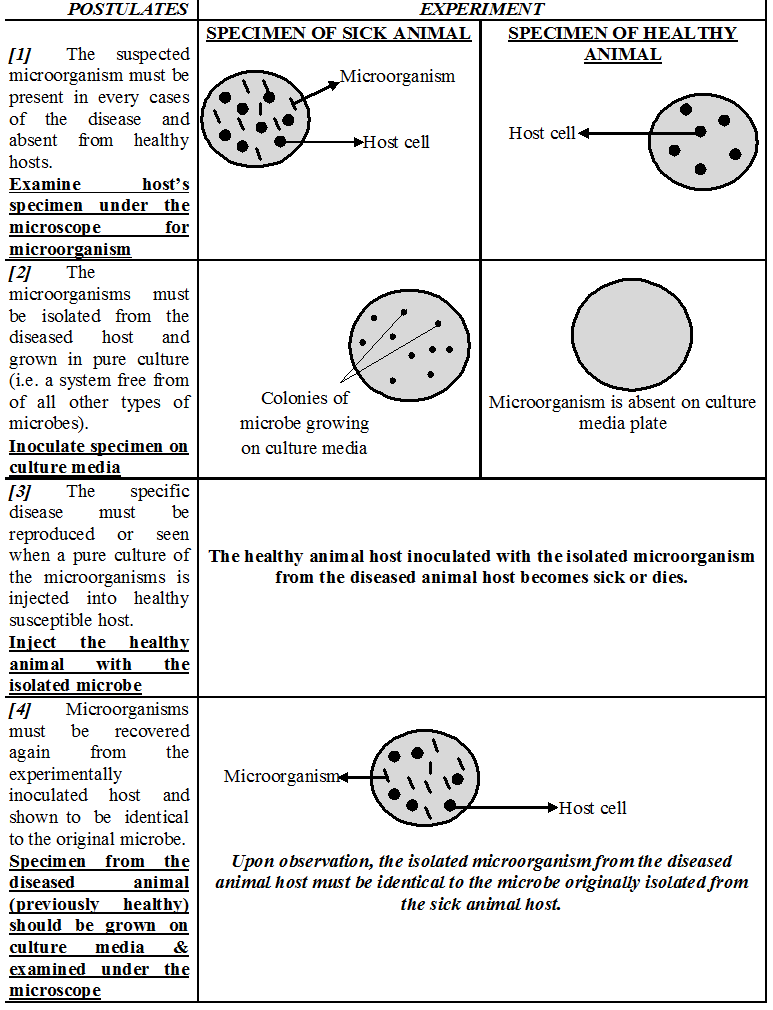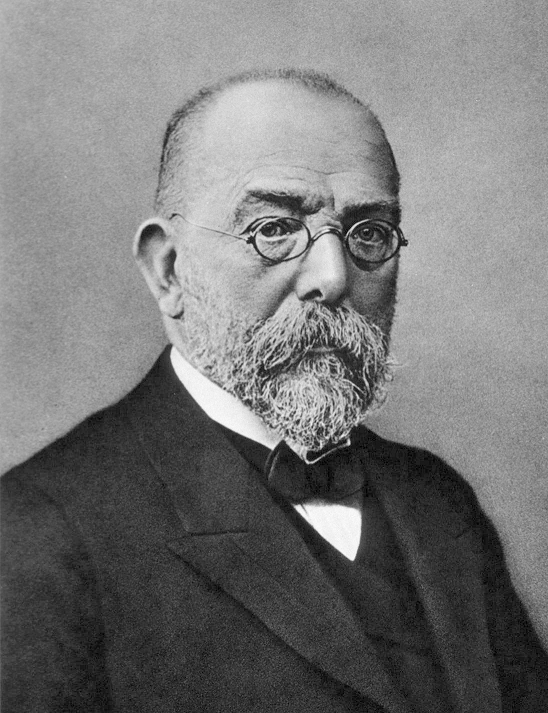Robert Koch, a German scientist was the first medical microbiologist. Koch was also the first to establish the actual relationship between the causative agent of a disease and the disease condition itself. Koch ushered in the beginning of bacteriology, an important field in microbiology that studies bacteria; and he is thus regarded as the father of bacteriology because he successfully isolated several disease-causing bacteria and even discovered the animal vectors of a number of human diseases including anthrax. Robert Koch successfully proved in his experiment that Bacillus anthracis caused anthrax, a bacterial disease of cattle and sheep which can be transmitted to humans via contact with infected animals or their products. Thus, Koch was the first to demonstrate and point out the fact that a particular disease is caused by a given microorganism. Anthrax is a disease that occurs primarily in animals but can also occur in humans, and it is thus a zoonotic infection since it can be transmitted from animals to humans.
It is a deadly blood disease that occurs in herbivores such as horses, sheep’s and cattle’s when they ingest the spores of B. anthracis during grazing in the fields. Robert Koch’s work on anthrax, tuberculosis (caused by Mycobacterium tuberculosis), rabies (caused by a virus) and cholera (caused by Vibrio cholerae)gave rise to the field of medical microbiology, which today is saddled with the primary responsibility of unraveling the causative agents of microbial diseases of man from clinically important specimens. Koch also confirmed the work of other microbiologists particularly that of Louis Pasteur on the “Germ Theory of Disease” which he took several steps further; even as he independently established “the relationship or link between a particular microorganism and a disease”. This is known as the germ theory of disease – which postulates that a particular microorganism is responsible for the cause of a specific disease. Koch’s criteria became known as Koch’s postulates and are still used today in the medical profession to link a particular disease to a particular microorganism.
Robert Koch’s postulates helps microbiologists and other medical and biomedical scientists to establish ways of combating pathogenic microorganisms and finding possible cures for the disease that they cause through the identification of the causative agents of the infection or disease. Robert Koch’s work actually started with a study of B. anthracis, and then later with the culturing of the microorganisms responsible for causing tuberculosis and cholera, Mycobacterium tuberculosis and Vibrio cholerae respectively. Koch’s work on bacteriology is significant because his research saved many people’s lives from diseases such as typhoid, diphtheria, tetanus, syphilis, and anthrax as at the time and even till date; and he achieved this breakthroughs by finding the particular microorganisms responsible for these diseases using his set of postulates (generally known as Koch’s postulates) which are still used even till date both in the field of microbiology and even in aetiology and in the medical sciences to unravel disease causes. Aetiology is the scientific study of the origin and causes of infectious diseases. Microbiologists don’t have to worry about wondering how an infectious disease foments or what actually caused a particular infectious disease because of Robert Koch’s groundbreaking research.
Because of his work in establishing the link between a disease and its causative agent, Robert Koch was awarded the 1905 Nobel Prize for Physiology or Medicine for his outstanding contributions on tuberculosis. The definite proof that microorganisms could cause disease provided the greatest scientific impetus for the development of the field of microbiology. Koch’s discovery and significant contribution in the field of microbiology led to the development of pure culture techniques, stains, agar/culture media and Petri dishes which complimented the study of microbiology. Koch’s postulates work very well for a handful of pathogenic microorganisms and the diseases that they cause; but however, this pioneering landmark in the determination of the causative agent of a particular disease does not still work well for all pathogenic microorganisms. Some infections or disease do not produce signs and symptoms in the host, and as such makes it difficult to associate such a disease to a particular microorganism. Secondly, some pathogenic microorganisms such as viruses cannot be easily cultured in vitro (i.e. outside a living host or in plates) as is the case with bacteria and fungi (which can easily be cultivated in vitro); and ethical considerations in medical practice disallows the direct inoculation of such infectious agents into human subjects for medical research.
However, recent discoveries in microbiology such as gene cloning and recombinant DNA technology amongst others afford microbiologists the chance to isolate and clone the genes responsible for virulence and/or pathogenicity in infectious agents (inclusive of bacteria, viruses, protozoa and fungi). In summary, Koch was renowned for his pioneering works in bacteriology especially in the discovery of the causative agents of some infectious diseases including cholera, anthrax and tuberculosis. He also formulated the Koch’s postulates, devised means for isolation of pure culture and discovered the tubercle bacilli.
ROBERT KOCH POSTULATES
Koch’s postulates are sets of scientific criteria which links a particular microorganism to a particular disease (Figure 1). The Koch’s postulates of disease cause are as follows:
- The suspected microorganism must be present in every cases of the disease and absent from healthy hosts.
- The microorganisms must be isolated from the diseased host and grown in pure culture (i.e. a system free from of other types of microbes).
- The specific disease must be reproduced or seen when a pure culture of the microorganisms is injected into healthy susceptible host.
- Microorganisms must be recovered again from the experimentally inoculated host and shown to be identical to the original one.

The molecular postulates of Koch’s principle of disease-cause which is mainly interested in the virulence genes present in the pathogenic microorganism (i.e. the genetic information which directs the disease course in the affected host) shall be highlighted in this unit.
- The virulence trait under study should be associated much more with pathogenic strains of the species than with non-pathogenic strains.
- Inactivation of the gene(s) associated with the suspected virulence trait should substantially decrease pathogenicity in the host.
- Replacement of the mutated gene with the normal wild-type gene should fully develop pathogenicity in the host.
- The gene should be expressed at some point during the infection and disease process in the host.
- Therapeutic substances such as antibodies or immune system cells directed against the gene products in the infected host (for healing purposes) should protect the host.
References
Barrett J.T (1998). Microbiology and Immunology Concepts. Philadelphia, PA: Lippincott-Raven Publishers. USA.
Beck R.W (2000). A chronology of microbiology in historical context. Washington, D.C.: ASM Press.
Brooks G.F., Butel J.S and Morse S.A (2004). Medical Microbiology, 23rd edition. McGraw Hill Publishers. USA. Pp. 248-260.
Chung K.T, Stevens Jr., S.E and Ferris D.H (1995). A chronology of events and pioneers of microbiology. SIM News, 45(1):3–13.
Drews G (1999). Ferdinand Cohn, among the Founder of Microbiology. ASM News 65(8):547.
Gest H (2005). The remarkable vision of Robert Hooke (1635-1703): first observer of the microbial world”. Perspect. Biol. Med, 48(2):266–272.
Nester E.W, Anderson D.G, Roberts C.E and Nester M.T (2009). Microbiology: A Human Perspective. Sixth edition. McGraw-Hill Companies, Inc, New York, USA.
Salyers A.A and Whitt D.D (2001). Microbiology: diversity, disease, and the environment. Fitzgerald Science Press Inc. Maryland, USA.
Slonczewski J.L, Foster J.W and Gillen K.M (2011). Microbiology: An Evolving Science. Second edition. W.W. Norton and Company, Inc, New York, USA.
Summers W.C (2000). History of microbiology. In Encyclopedia of microbiology, vol. 2, J. Lederberg, editor, 677–97. San Diego: Academic Press.
Talaro, Kathleen P (2005). Foundations in Microbiology. 5th edition. McGraw-Hill Companies Inc., New York, USA.
Wainwright M (2003). An Alternative View of the Early History of Microbiology. Advances in applied microbiology. Advances in Applied Microbiology, 52:333–355.
Willey J.M, Sherwood L.M and Woolverton C.J (2008). Harley and Klein’s Microbiology. 7th ed. McGraw-Hill Higher Education, USA.
Discover more from #1 Microbiology Resource Hub
Subscribe to get the latest posts to your email.



